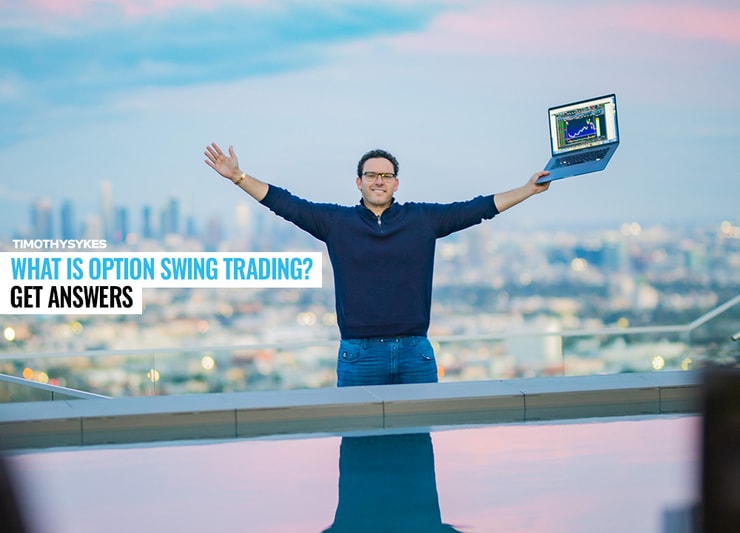Options swing trading is a strategy for active options trading. Like stock swing trading, it fits the kind of active investor who works on a slightly longer timeframe…
Swing trading is still bound by the rules I teach. Unlike the “hold and hope” non-strategy, swing trading is a form of active trading, with risk and a profit goal built in.
I’m more of a day trader, but many of my students have successfully applied my rules to swing trading. Here I’ll cover how to apply this strategy to options trading, its pros and cons, what indicators to look for, and more.
Let’s dive in!
Table of Contents
- 1 What Is Options Swing Trading?
- 2 How Does Swing Trading Differ From Day Trading?
- 3 How to Swing Trade Options
- 4 Pros of Options Swing Trades
- 5 Cons of Option Swing Trades
- 6 Example of Options Swing Trades
- 7 What Is a Good Delta for Swing Trading Options?
- 8 Choosing Expiration and Strike Price
- 9 Which Indicator Is Best for Swing Trading?
- 10 What Percentage of Options Traders Are Successful?
- 11 What Is the Safest Options Trading Strategy?
- 12 Why Do Most Swing Traders Fail?
- 13 Options Swing Trading Best Practices
- 14 Key Takeaways
What Is Options Swing Trading?

2025 Millionaire Media, LLCOptions swing trading is a strategy where you take advantage of short-term price moves. The timeframe you trade on can be anywhere from a few days to a few weeks.
This method is called “swing” trading because you’re profiting from price swings. You also take advantage of financial market movements.
Swing trading can be less stressful than day trading. Day trades are measured in minutes or hours, and can go from profit to loss if you don’t act quickly enough.
Are you learning the basics of options trading? Check out my guides on options margin, strike prices, and spread option trading.
How Does Swing Trading Differ From Day Trading?
Besides the obvious differences in timeframe, swing trading is different from day trading in its approach. Day traders look for small price movements within a single trading day. Swing traders look for larger price movement over several days or weeks.
The different timeframes can have different risks. Day traders are usually attracted to volatile stocks — they give the greatest possibility for short-term gains. But they can also go against reckless traders quickly.
Swing traders often target slower price moves, which take a longer time to play out. But nothing is guaranteed in the market. Taking your eyes off a stock is a good way to find yourself in a bad situation.
How to Swing Trade Options
Considering getting into options swing trading? Here’s a step-by-step guide to implementing swing trading strategies for options:
- Check the chart. If you see a multi-week breakout in the chart, it might be a good candidate for an options swing trade.
- Build a trading plan. This should contain your risk and profit objectives.
- Enter your options trade. Depending on your strategy, this can go 1,000 different ways. But the main idea is that you want to translate your trading plan to things like strike price and expiration date.
- Consider your options. You can trade the option to lock in profits or limit losses. You can also revise your risk, if the underlying asset is trending up (or down for puts) and you want to let the move play out before cashing in.
- Log your results in your trading journal. A great swing trading strategy is always being fine-tuned. Your strategy is only as good as your record says it is.
The best options broker doesn’t get in the way of your trading. Check out my list of the best options brokers for most traders.
Pros of Options Swing Trades
Options swing trading is a great alternative if you can’t commit to day trading. Here are some of the pros of options swing trades:
Needs Less Trading Time
Day traders can spend hours and hours watching charts throughout the day. But this doesn’t fit into everyone’s schedule. Some swing traders hold assets for days or even weeks, and manage to become profitable without turning trading into a 9-to-5 job.
Doesn’t Sacrifice Short-Term Profit
Like day trading, some swing strategies target short-term price movements. For some traders, this is a good compromise between ultra-active trading and slower-paced swing trading strategies.
More Breaking News
- Recursion Pharmaceuticals Stock Slide: A Key Event?
- SEALSQ Corp’s Strategic Moves Drive Stocks Amid Market Unrest
- VNET’s Financial Strength Sends Positive Ripple in the Market
Cuts the Noise Out of Trading
Volatility can be both a blessing and a curse for traders. Short-term volatility can result in traders blowing through their stops. By targeting longer timeframes and having more forgiving risk, you can allow moves to play out while ignoring volatility blips.
Cons of Option Swing Trades

2025 Millionaire Media, LLCOn the flip side, swing trading can have some drawbacks. Here are some of them:
Exposes You to Price Gaps
Swing traders typically hold positions across multiple days. This might expose you to overnight and weekend price gaps.
Price gaps are when an asset opens at a vastly different price than the previous day. This can happen because of newsworthy events happening outside trading hours, as well as market sentiment.
For the penny stocks I like to trade, this can be a big risk.
Lulls You into a False Sense of Security
Just because your trading plan has a longer timeframe doesn’t mean the markets will cooperate! Any time the markets are open, you have to be paying attention.
Example of Options Swing Trades
What does an options swing trade look like in action? Here’s an illustration:
Let’s say Company A’s current stock price is $8.50 per share. But Company A’s industry is in a long-term downtrend.
You buy put options with a $6.50 strike price that expire a month from now. These puts are far out of the money, so their premium is cheap — just 20 cents. That comes out to $20 for the contract, with a potential profit of $180 if it hits the strike price.
The early results look good. Company A’s stock price plummets to $6.75 the next week. Prices haven’t reached the strike price yet, so you can’t exercise your contracts. But the premium on your option has soared to $1.60.
You don’t have to exercise the contracts to profit. You can just sell the contract and receive the new premium, earning a profit of $140 minus fees.
What Is a Good Delta for Swing Trading Options?

2025 Millionaire Media, LLCA good delta for swing trading options depends on your strategy.
Options with higher delta values are more expensive. They build more value as the underlying stock moves, because they’re more likely to expire in the money.
Options with lower delta values are less likely to expire in the money. This makes for a lower premium.
Just like in most trading considerations, there’s no easy answer here. Whatever delta you target in the options you trade, make sure it’s consistent with your strategy.
Liquidity is also important. The option will have to be liquid enough to ensure there are buyers and sellers to partner with on your trades.
Choosing Expiration and Strike Price
Expiration and strike price are two of the most important elements of your options contract. How do you set them? It’s all part of a good trading plan.
Check out my guide to building a trading plan here.
A shorter time until expiration means you won’t have much time for the asset to change price. Out-of-the-money trades will have less of a chance of hitting their strike prices, while in-the-money trades will have a higher premium.
Something to remember is that options also have time value. This is like an adaptive expiration, affecting the value of the option as it gets closer to expiration.
You should consider implied volatility, liquidity, and market conditions when setting a strike price. High implied volatility options will cost more the closer they are to their strike price. That’s because a volatility blip can be enough to make them executable.
Which Indicator Is Best for Swing Trading?
These three technical indicators are often used in swing trading:
- Bollinger Bands: This swing trading indicator measures an asset’s volatility. The bands expand when volatility increases and contract when volatility decreases.
- Relative Strength Index (RSI): This indicator measures whether an asset is oversold or overbought. RSI ranges from 0 to 100. Anything under 30 means the asset is oversold, while anything over 70 means it’s overbought.
- Put-Call Ratio (PCR): This ratio calculates option trading volume by dividing the open interest of puts by that of calls. A PCR above 1 indicates a bearish market because there are more puts than calls. A PCR under 1 indicates a bullish market because there are more calls than puts.
What Percentage of Options Traders Are Successful?

2025 Millionaire Media, LLCOnly a small percentage of options traders are successful. I’m not gonna sugarcoat it — trading is one of the hardest things you’ll ever learn, and not everybody will succeed.
There’s great risk in trading. A 2019 study called “Day Trading for a Living?” looked at the success rates of Brazilian futures traders over a 2-year window, and found that 97% of traders with more than 300 days actively trading lost money. Only 1.1% earned more than the Brazilian minimum wage ($16 USD per day).
This was futures, not standard options. Maybe you don’t intend to be that active of a trader … but you get the point.
I’m not saying you can’t succeed. You can succeed, but it takes time and commitment. So, study hard and learn from each trade. The key to successful options trading is building your skills every day.
How do you know if your options trades are successful? Here’s a guide to calculating options trading profits.
What Is the Safest Options Trading Strategy?
There’s no “safest” options trading strategy — every trading strategy has various levels of risk. But selling covered calls and cash-covered puts are some of the least risky strategies. They don’t expose you to the unlimited risk of some higher-level options strategies.
Why Do Most Swing Traders Fail?
Most swing traders fail because they don’t take it seriously. Many of them treat trading like gambling and don’t do their research. They don’t have a plan, and make random trades.
The key to making any style of trading work is discipline. Discipline is what makes you commit to your trading plan, instead of falling in love with a winning trade or holding it past your risk on a losing one. Discipline is what keeps you tracking your trades, and adjusting your strategy as necessary.
Options Swing Trading Best Practices
Every trader has different goals and strategies, but some tips benefit everyone. Here are several best practices to follow when swing trading options:
- Cut losses quickly. Even if you’re swing trading, this is always rule #1.
- Keep track of your trades. You can’t be an absent trader and hope to profit.
- Maintain alerts. These can help you monitor your trades even when you’re not watching a screen.
Key Takeaways
Options swing trading is an alternative to day trading that fits the lifestyle and temperament of some traders. In swing trading, you typically hold onto positions for multiple days to take advantage of price swings.
It fits some traders really well. Some have high blood pressure and don’t want to deal with the stress of day trading. Some have full-time jobs or live in other time zones and can’t watch the markets all day.
There’s a flip side to these advantages though — some swing traders treat the strategy as a “set-it-and-forget-it” solution to making money. A cousin of “get rich quick,” this approach never works. Whatever trading strategy works best for you, trading success will require working harder than you ever have.
Becoming a successful swing trader means studying hard to build trading experience. You don’t have to do it alone, either.
I recommend getting some expert guidance.
I don’t trade options — I leave it to pros like tech entrepreneur and trader Ben Sturgill. His smart-money webinars are the product of more than 2 decades of experience in the market and a unique technology, and they’re well worth checking out.
Check out the webinar here to see why Ben’s smart-money scanner has been going haywire lately!
What do you think of options swing trading? Do you have some tips to share? Let me know in the comments!









Leave a reply